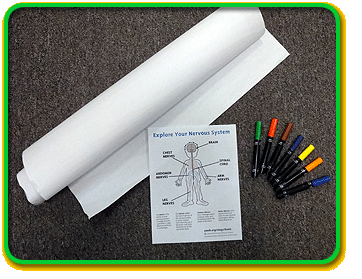
Whenever you see, hear, and feel — and whenever you think, move, and even breathe — your brain buzzes with the activity of neurons.

Neurons are tiny cells that are the building blocks of the nervous system . They come in many shapes and sizes. Some stretch from the spinal cord all the way to the toes and can be more than 3 feet (1 meter) long!
Neurons send messages from different parts of your body to your brain , all around your brain, and from your brain out to the muscles in your body.
They can send more than 100 signals a second, at speeds up to 400 kilometers (250 miles) an hour. That's four times faster than a moving car on the highway!

Find out more about your nervous system by creating a life-sized drawing.
What You'll Need

- a large sheet of paper, wrapping paper, or unwaxed butcher paper
- washable markers or crayons
- a friend
- download and print Explore Your Nervous System (PDF)
Sidewalk Art
As another option, use chalk to draw your nervous system on the sidewalk.
What to Do

Cut a sheet of paper that is longer than the height of your friend. (Or, tape sheets of paper together.)

Place the paper on a hard, smooth floor. Have your friend lay down in the middle of the paper.
Use a black marker to draw an outline of your friend's body.


Next, draw the different parts of the nervous system. Then, label them. Use the Explore Your Nervous System (PDF) as a reference.



Hang the drawing on a wall or inside your closet door to show off your nerves!

Did you know?
- Some messages shoot through the nervous system faster than others. When you pet a fluffy dog, one signal races from your fingertip to your brain in 10 to 20 milliseconds, letting you know she is soft. Another signal reaches your brain in a few milliseconds later, telling you she is warm.
- Nerves on the right side of the body connect to the left side of the brain. Nerves on the left side of the body connect to the right side of the brain.
- The nervous system runs on electricity, but the levels are low. Brain signals involve less than one-tenth the voltage of an ordinary flashlight battery




 Biodiversity
Biodiversity
 Brain
Brain
 Genetics
Genetics
 Marine BiOLogy
Marine BiOLogy
 MicrobiOLogy
MicrobiOLogy
 PaleontOLogy
PaleontOLogy
 ZoOLogy
ZoOLogy
 AnthropOLogy
AnthropOLogy
 ArchaeOLogy
ArchaeOLogy
 Astronomy
Astronomy
 Climate Change
Climate Change
 Earth
Earth
 Physics
Physics
 Water
Water
